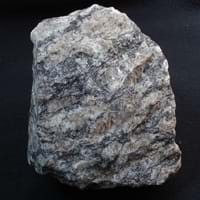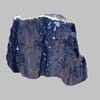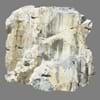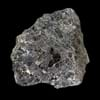Tuff and Gneiss
Definition
Definition
Tuff is a type of rock made of volcanic ash ejected from a vent during a volcanic eruption
Gneiss is a common and widely distributed type of rock formed by high-grade regional metamorphic processes from pre-existing formations that were originally either igneous or sedimentary rocks
History
Origin
Italy
Unknown
Discoverer
Unknown
Unknown
Etymology
From a Latin word tophous then in Italian tufo and finally tuff
From the Middle High German verb gneist (to spark; so called because the rock glitters)
Class
Igneous Rocks
Metamorphic Rocks
Sub-Class
Durable Rock, Medium Hardness Rock
Durable Rock, Hard Rock
Family
Group
Volcanic
Not Applicable
Other Categories
Fine Grained Rock, Opaque Rock
Coarse Grained Rock, Medium Grained Rock, Opaque Rock
Texture
Texture
Clastic, Pyroclastic
Banded, Foliated, Platy
Color
Brown, Grey, Yellow
Black, Brown, Pink, Red, White
Maintenance
More
More
Durability
Durable
Durable
Water Resistant
Yes
Yes
Scratch Resistant
Yes
Yes
Stain Resistant
No
Yes
Wind Resistant
No
Yes
Acid Resistant
No
No
Appearance
Dull, Vesicular and Foilated
Foliated
Uses
Architecture
Interior Uses
Decorative Aggregates, Entryways, Flooring, Homes, Interior Decoration
Countertops, Decorative Aggregates, Flooring, Interior Decoration
Exterior Uses
As Building Stone, As Facing Stone, Garden Decoration, Office Buildings, Paving Stone
As Building Stone, As Facing Stone, Garden Decoration, Paving Stone
Other Architectural Uses
Curbing
Curbing
Industry
Construction Industry
Building houses or walls, Construction Aggregate
As Dimension Stone
Medical Industry
Not Yet Used
Not Yet Used
Antiquity Uses
Artifacts, Monuments, Sculpture, Small Figurines
Artifacts
Other Uses
Commercial Uses
Creating Artwork
Cemetery Markers, Jewelry, Tombstones, Used in aquariums
Types
Types
Welded tuff, Rhyolitic tuff, Basaltic tuff, Trachyte tuff, Andesitic tuff and Ignimbrite.
Augen Gneiss, Henderson Gneiss, Lewisian Gneiss, Archean and Proterozoic Gneiss.
Features
Always found as volcanic pipes over deep continental crust
Generally rough to touch, Is one of the oldest rock
Archaeological Significance
Monuments
Used
Used
Famous Monuments
Easter Island in the Polynesian Triangle, Pacific Ocean
Konark Sun Temple in India, Washington Monument, US
Sculpture
Used
Not Yet Used
Famous Sculptures
Data Not Available
Not Applicable
Pictographs
Used
Not Used
Petroglyphs
Used
Not Used
Figurines
Used
Not Yet Used
Fossils
Absent
Absent
Formation
Formation
Tuff is formed when large masses of ash and sand which are mixed with hot gases are ejected by a volcano and avalanche rapidly down its slopes.
Gneiss is a high grade metamorphic rock i.e. it has been subjected to higher temperatures and pressures than schist. It is formed by the metamorphosis of Gneiss forms from volcanic rock, shale or granitie.
Composition
Mineral Content
Calcite, Chlorite
Biotite, Chlorite, Feldspar, Garnet, Graphite, Hornblade, Micas, Muscovite or Illite, Quartz, Quartzite, Silica, Zircon
Compound Content
Hydrogen Sulfide, Sulfur Dioxide
Aluminium Oxide, NaCl, CaO, Iron(III) Oxide, FeO, Potassium Oxide, Magnesium Carbonate, MgO, MnO, Phosphorus Pentoxide, Silicon Dioxide, Titanium Dioxide
Transformation
Metamorphism
Yes
Yes
Types of Metamorphism
Burial Metamorphism, Cataclastic Metamorphism, Contact Metamorphism, Hydrothermal Metamorphism, Impact Metamorphism, Regional Metamorphism
Impact Metamorphism
Weathering
Yes
Yes
Types of Weathering
Biological Weathering, Chemical Weathering, Mechanical Weathering
Biological Weathering, Mechanical Weathering
Erosion
Yes
Yes
Types of Erosion
Chemical Erosion, Coastal Erosion, Glacier Erosion, Sea Erosion, Water Erosion, Wind Erosion
Chemical Erosion, Coastal Erosion, Sea Erosion
Properties
Physical Properties
Hardness
4-6
7
Grain Size
Fine Grained
Medium to Coarse Grained
Fracture
Uneven
Irregular
Streak
White
White
Porosity
Highly Porous
Very Less Porous
Luster
Vitreous to Dull
Dull
Compressive Strength
243.80 N/mm2
5
125.00 N/mm2
17
Cleavage
Not Available
Poor
Toughness
Not Available
1.2
Specific Gravity
2.73
2.5-2.7
Transparency
Opaque
Translucent to Opaque
Density
1-1.8 g/cm3
2.6-2.9 g/cm3
Thermal Properties
Specific Heat Capacity
0.20 kJ/Kg K
25
Not Available
Resistance
Heat Resistant, Impact Resistant, Pressure Resistant, Wear Resistant
Heat Resistant, Pressure Resistant, Scratch Resistant, Wear Resistant
Reserves
Deposits in Eastern Continents
Asia
Afghanistan, Armenia, Azerbaijan, Burma, Cambodia, China, India, Indonesia, Iran, Japan, Malaysia, Mongolia, Nepal, North Korea, Pakistan, Saudi Arabia, Syria, Taiwan, Thailand, Turkey, Vietnam, Yemen
China, India, Iran, Iraq, Kazakhstan, Kyrgyzstan, Mongolia, Russia
Africa
Cameroon, Cape Verde, Eritrea, Ethiopia, Kenya, Libya, Madagascar, Nigeria, Rwanda, South Africa, Sudan, Uganda
Cameroon, Ethiopia, Ghana, Kenya, Madagascar, Morocco, Mozambique, Namibia, Nigeria, Tanzania, Togo
Europe
France, Georgia, Germany, Greece, Iceland, Italy, Netherlands, Poland, Portugal, Spain, United Kingdom
Albania, Austria, Bosnia and Herzegovina, Finland, France, Georgia, Germany, Hungary, Italy, Kosovo, Monaco, Norway, Poland, Romania, Serbia, Slovakia, Slovenia, Switzerland, Ukraine, United Kingdom
Others
Antarctica, Hawaii Islands
Not Yet Found
Deposits in Western Continents
North America
Canada, Costa Rica, Panama, USA
Canada, Costa Rica, Cuba, Mexico, Panama, USA
South America
Argentina, Bolivia, Brazil, Chile, Ecuador, Paraguay
Argentina, Bolivia, Brazil, Chile, Colombia, Ecuador, Peru, Venezuela
Deposits in Oceania Continent
Australia
Central Australia, Western Australia
New South Wales, New Zealand, Queensland, Victoria
All about Tuff and Gneiss Properties
Know all about Tuff and Gneiss properties here. All properties of rocks are important as they define the type of rock and its application. Tuff belongs to Igneous Rocks while Gneiss belongs to Metamorphic Rocks.Texture of Tuff is Clastic, Pyroclastic whereas that of Gneiss is Banded, Foliated, Platy. Tuff appears Dull, Vesicular and Foilated and Gneiss appears Foliated. The luster of Tuff is vitreous to dull while that of Gneiss is dull. Tuff is available in brown, grey, yellow colors whereas Gneiss is available in black, brown, pink, red, white colors. The commercial uses of Tuff are creating artwork and that of Gneiss are cemetery markers, jewelry, tombstones, used in aquariums.
|
||
|
||
|










